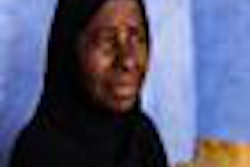
Due to limited access to mammography, researchers from Sudan and the U.S. developed a breast screening program in Sudan that relied on clinical breast exams and self-examination. The inexpensive program used local volunteers and resulted in earlier detection of breast cancer compared with when no screening takes place.
The study, led by Dr. Sulma Mohammed, of the University of Gezira in Sudan and Purdue University in the U.S., is the first-ever assessment of the effect of cancer screening in rural sub-Saharan Africa (Lancet Oncology, 31 January 2013).
Breast cancer's heavy toll
Breast cancer is the second leading cause of death in women in Africa, and has significant geographical variation in incidence and mortality across the continent. In Sudan, breast cancer accounts for about one-third of all cancers. In a descriptive study conducted in Sudan in 2010, the prevalence of advanced, stage III, or worse metastatic disease was higher in women living in rural areas than it was in women living in urban areas.
"In general, women living in sub-Saharan African countries present with advanced-stage disease that is difficult to treat and results in death," Mohammed and colleagues wrote. "By contrast, breast cancer deaths in high-income countries are in decline. This decrease is largely driven by the implementation of cancer screening programs and the availability of effective treatments."
Implementing an effective screening program using the traditional means of mammography in Africa is challenging because sub-Saharan countries do not have the infrastructure, resources, or trained personnel to undertake such programs effectively, especially in areas outside major cities. Also, health education is poor, and few people are aware of cancer.
For most African women, the appearance of a mass is usually not thought of as life-threatening and is ignored, Mohammed and colleagues noted. "Some women might seek treatment from a traditional healer. For others, to leave familiar surroundings and seek medical care often seems too difficult ... too expensive, or a cause of too much anxiety," they wrote.
Mammography is a lifesaving technology, but there has also been much debate about overdiagnosis, the authors wrote. In addition, "Nonmammographic early detection through awareness campaigns have been shown to have substantial positive effects and to contribute to almost half of the decrease in breast cancer mortality in high-income countries," they added.
Mohammed and colleagues sought to test the effectiveness of such a program by conducting a pilot study on raising breast cancer awareness using volunteers in two counties in the state of Gezira in Sudan.
How they did it
The county of Keremet (56 villages) was the experimental county, while Abugota (79 villages) was the control county. Female volunteers from villages in Keremet were trained in detecting breast abnormalities using clinical breast exam techniques, then visited households in their village and screened women age 18 years or older for breast abnormalities, referring women with suspected breast cancer for medical diagnosis and, if necessary, treatment at the district hospital. Villages in the control population received no intervention.
Between 1 January 2010 and 10 October 2012, 10,309 women were screened, which is 70% of the total female population of Keremet County. As a result, 138 women were referred directly to the nearest specialist cancer center; 101 of these were diagnosed with benign lesions and given appropriate treatment; 12 were diagnosed with either breast cancer or ductal carcinoma in situ (DCIS), which was subsequently successfully treated, with no signs of progression at the last date of follow-up.
Twenty of the women referred to the specialist center did not attend, two of the women diagnosed with breast cancer refused treatment, and two had advanced disease at the time of referral and died. Another woman was already aware of her diagnosis and received treatment elsewhere.
The researchers plan to follow up with the breast cancer patients for at least five years for any change in their status or recurrences of disease.
The study had a detection rate for invasive cancer and DCIS of 1.1%. In comparison with a high-income country using mammography screening, recent study from Germany found the detection rate to be 81 per 10,000 women, or 0.8%.
For the Sudanese study, in the control group in which no breast cancer screening program occurred, Abugota County, four women referred themselves to the cancer center during the study period: one had a benign lesion, and the other three had advanced disease that was treated. One woman went into remission, and the two did not respond to treatment and had poor prognoses at the time of final follow-up.
The researchers admit they were not surprised the two Keremet women who died within two months of diagnosis had not sought cancer treatment despite the late stage of their disease.
The reasons women don't seek treatment include poor cancer awareness, attitudes about the disease, and fear of surgery and mastectomy, especially in a society dominated by men and in which men can have more than one wife. Because breast cancer in Sudanese women, and in African women in general, often occurs at a younger age than in high-income countries, women often fear stigmatization, the loss of a breast, and the loss of her husband, and perhaps support for her children, the researchers added.
"Furthermore, some African communities are Muslim. Women's belief that Allah determines their fate, in addition to their Islamic beliefs, which require women to be completely covered, can hinder women's decisions to seek medical help," Mohammed and colleagues wrote. "For a woman to expose her breasts to a male doctor or nurse as part of a screening program would not be acceptable to either them or their husbands. Similar factors probably played a part in the decisions of the 20 women who were referred for follow-up but did not report to the [National Cancer Institute-Gezira University]."
Indeed, in a study presented at this week's Arab Health 2013 congress in Dubai, Egyptian researchers expressed frustration with the large numbers of women in their country who never showed up for follow-up after receiving a suspicious mammogram.
The intervention proposed in this study could break down some of the barriers that prevent women from seeking professional help and could raise awareness about the importance of early detection in low-income communities, the authors added. When mammography is unavailable, this type of program should decrease morbidity, increase women's survival, and increase their number of productive years of life.
"It could also inform public policy and influence public and governmental attitudes toward cancer awareness and interventions," Mohammed and colleagues concluded.



















